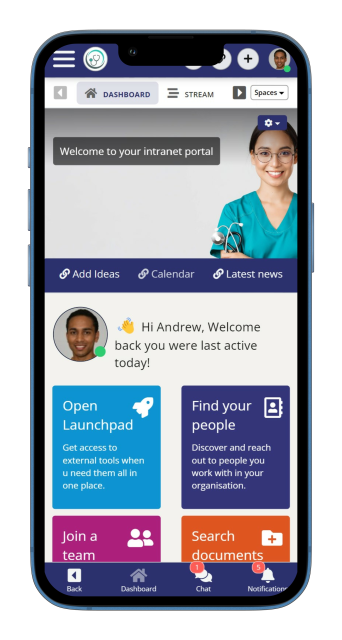Insight Blog
Agility’s perspectives on transforming the employee's experience throughout remote transformation using connected enterprise tools.
19 minutes reading time
(3746 words)
What are the Implications of AI on Workforce Diversity and Inclusion?
What are the implications of AI on workforce diversity and inclusion? Discover how AI can have positive and negative impact on workforce diversity and inclusion.
What are the implications of AI on workforce diversity and inclusion? This question is now even more pertinent in the times of AI when its role in the workforce is growing.
Diversity and inclusion in workplaces is the one of the necessary conditions of creating a dynamic, innovative and competitive business environment. They offer different views, experiences, and assets that fuel the creative process and are in line with a diverse target market. Similarly, AI's being infused in business processes is the key to changing job roles, recruitment methods, and staff training.
Analyzing how AI affects these factors is critical for holding the status quo and boosting diversity and inclusion in the present workplace and for the future workforce where technological advancements are more beneficial for the entire workforce.
Why Workforce Diversity and Inclusion is Important?
Workforce diversity and inclusion are the sources of an immeasurable number of advantages as they are a moral, social and financial issue.
Morally, it's about fairness and inclusivity, guaranteeing that all, regardless of their social status, are given equal chances. Socially, the diversity of the workforce allows for a livelier, creative environment where many opinions brought in by different perspectives lead to creative solutions and more ideas.
From the economic perspective, diversity is a factor that has a positive impact on the success of the business; companies, which have various nationalities in their staff, outrun companies, which are mono-ethnic, as they better understand and satisfy more global consumer needs. Subsequently, being diverse and inclusive is not only a moral essential but a strong strategic advantage as a result of our interconnected world.
Role of diversity and inclusion in AI
Diversity and inclusion play critical roles in the development and deployment of artificial intelligence (AI). Here are some key aspects:
- Representativeness in Data: AI systems are trained on data, and if the data used for training is not diverse, the AI model may exhibit biases. Diversity in data ensures that AI systems are trained on a wide range of examples, representing different demographics, cultures, and backgrounds. This helps in creating more inclusive and fair AI systems that work well for everyone.
- Algorithmic Fairness: Diversity and inclusion are essential for ensuring algorithmic fairness. Biases can inadvertently creep into AI algorithms due to skewed data or underlying assumptions. By incorporating diverse perspectives in the development process, it becomes possible to identify and mitigate biases, thus promoting fairness and equity in AI applications.
- User Experience and Accessibility: Embracing diversity and inclusion in AI design enhances user experience and accessibility. Considering a diverse range of users during the design phase ensures that AI systems cater to the needs of various individuals, including those with disabilities or from underrepresented communities. This leads to more user-friendly and inclusive technologies.
- Innovation and Creativity: Diversity fosters innovation and creativity in AI development. By bringing together people from different backgrounds, experiences, and perspectives, AI teams can leverage a broader range of ideas and approaches. This diversity of thought can lead to the creation of more innovative and effective AI solutions that address a wider array of challenges.
- Ethical Considerations: Diversity and inclusion are closely linked to ethical considerations in AI. Ensuring that AI systems are developed and deployed in a manner that respects diversity and promotes inclusion helps in building trust and credibility among users and stakeholders. It also aligns AI initiatives with ethical principles such as fairness, transparency, and accountability.
- Social Impact: AI has the potential to impact society in profound ways. Embracing diversity and inclusion ensures that AI technologies benefit all members of society, including marginalized and underrepresented groups. By addressing societal challenges through inclusive AI solutions, we can work towards creating a more equitable and just world.
In summary, diversity and inclusion are essential considerations in AI development and deployment. By promoting diversity in data, algorithms, teams, and perspectives, we can create AI systems that are more ethical, fair, inclusive, and beneficial for society as a whole.
Challenges and Ethical Considerations of AI in DEI
While AI offers significant potential to advance diversity, equity, and inclusion (DEI) goals, its deployment is not without challenges and ethical considerations. The technology, designed to eliminate bias, can inadvertently perpetuate or exacerbate it if not carefully implemented and monitored.
One primary ethical concern surrounding AI's use in DEI efforts is the possibility for AI algorithms to inherit biases from historical data or the biases of their creators. If an AI system is trained on data reflecting past discriminatory hiring practices, it may continue favoring certain groups despite intentions to promote diversity.To address these risks, organizations must ensure the data used to train AI models is as unbiased as possible and regularly audit these models for discriminatory patterns. Transparency in AI decision-making processes is also crucial for allowing greater scrutiny and accountability.
Another challenge is balancing AI's efficiency and objectivity with humans' nuanced judgments.
While AI can screen candidates and identify potential biases at scale, final decisions about recruitment, promotions, and other critical aspects should involve human discretion. Humans can consider context, extenuating circumstances, and the multifaceted nature of diversity and inclusion in ways AI cannot.
Furthermore, reliance on AI must be tempered with an awareness of its limitations and ethical implications. Organizations must ensure that AI deployment in DEI initiatives adheres to fairness, transparency, and accountability principles. This includes selecting the right tools and training staff to use them responsibly while interpreting outputs critically.
AI presents both opportunities and challenges for advancing DEI in the workplace.
By leveraging AI tools thoughtfully and ethically, organizations can make significant strides in creating more inclusive environments. However, true diversity and inclusion require a careful balance of technology and human insight, emphasizing the importance of continuous vigilance and commitment to ethical principles in the AI era.
AI Tools and Applications for DEI
As organizations increasingly prioritize diversity, equity, and inclusion (DEI), they are turning to artificial intelligence (AI) as a powerful toolset to bolster these efforts. Yet, like any technology, using AI in DEI initiatives comes with challenges and ethical considerations. This segment of our examination delves into the innovative AI tools reshaping recruitment and bias detection while emphasizing the caution required to navigate the ethical terrain accompanying AI's integration into DEI strategies.
AI tools have transformed the recruitment landscape, providing unparalleled opportunities to enrich diversity. These tools encompass AI-driven job advertising platforms targeting diverse candidates and resume screening algorithms emphasizing skills and experiences while minimizing unconscious biases related to the applicant's identity markers such as name, gender, age, or ethnicity. For instance, specific AI recruitment tools anonymize and evaluate applications solely on merit, ensuring a more equitable selection process.Most importantly, AI-powered chatbots offer all candidates consistent information and support, ensuring an equitable recruitment experience. Predictive analytics can further assist organizations in pinpointing diversity gaps within their workforce, enabling targeted recruitment efforts to remedy these disparities. By harnessing these tools, companies can attract a broader range of applicants and take significant strides toward fostering a more inclusive workplace.
AI's influence extends beyond recruitment into bias detection and training realms. AI algorithms can scrutinize vast datasets to uncover patterns of bias within organizational practices and policies. Once identified, these insights can guide focused interventions to address and mitigate biases.
In the realm of training, AI-driven platforms provide personalized learning experiences adaptable to each employee's individual needs and learning styles. These platforms may also integrate bias detection training, employing interactive scenarios and real-time feedback to educate employees on recognizing and counteracting their unconscious biases. Organizations can nurture a culture of inclusion and respect by cultivating a more aware and knowledgeable workforce.
Follow us and access great exclusive content everyday: Follow us on Google News
Implications of AI on Workforce Diversity and Inclusion
1. Bias in AI Recruitment Tools
Bias in AI recruitment tools is a major misgiving, however the situation becomes even more alarming when these technologies are used for hiring purposes. AI systems similarly, which are implemented to automate the recruitment process, are based on the information gained from historical data.
This information, if it is the outdated prejudices or the skewed demographics, can be unintentionally learned by AI in order to reproduce the same biases. For example, for an AI that exhibits a bias towards a particular gender or ethnic group based on the historical hiring data can result in the unjust favor of the certain candidates that fit these profiles, and in turn, resulting in the continuation of the exclusion cycle.
Besides, AI may overlook diversity by narrowing the perspective down to some particular criteria which do not really capture the talent in full. This problem takes place where AI systems are programmed with certain keywords or traditional criteria of success that only come from the most prestigious educational backgrounds or from using certain work experience, which may not be that accessible for the candidates from diverse backgrounds.
You may also like: Best Apps for Employees: UPDATED 2022 – A Complete Guide
2. Automation and Job Displacement Risks
While AI driven automation is a great threat to jobs, minority groups are the most vulnerable as they face greater displacement risks.
AI's capacity to quickly run the activities that people have always been doing can lead to the decrease in the need for specific employment positions. The sad reality is these roles are mostly taken by workers from marginalized or low socio-economic status groups who might not have the opportunity to get the education and training that could help them transition to the AI resistant job positions. This disproportion may be highly detrimental and lead to exacerbation of the existing social-economical gaps.
Additionally, automation would be a major factor creating disparities within the society, especially for people working in the fields of manufacturing, retail or basic administrative jobs where routine tasks are common. With AI developing even further in the future, these occupations might be more automated, which in turn may reduce the number of people employed, especially members of vulnerable groups.
This should be a proactive process where everyone has equal chances to be reskilled and access education, so all sectors of the society are able to adjust and thrive in a future of work with AI at its core.
3. Enhanced Training and Upskilling Opportunities
AI opens a new window of perfected training and reskilling but with this being said, it is advantageous for the socially marginalized groups. If AI-dependent personalized training systems are applied, the training programs can be customized according to the learners' particular styles and necessities, making them more favorable.
This personalization will help employees with diverse backgrounds to develop skills from where they stand and according to their individual learning pathway. For the marginalized folks who might have had fewer chances than others to go through traditional education and training institutions, the AI-powered platforms are a true equalizer of the playing field. These trainings provide them with essential abilities to move up their career and overcome the challenges of changing job requirements.
Free ebook: How To Get Your Intranet Off The Ground
4. Global Talent Accessibility
AI's role in remote working has made global talent pools skillfully diverse and culturally wide, giving a great boost to the diversity of the workforce. AI tools have the capability of making remote work more efficient and therefore businesses can hire people from different regions or countries.
This mobility enables organizations to pick candidates from every corner of the globe, hence, organizations are more exposed to a diverse group of people. The creation of a multicultural work environment through bringing of the staff from various parts of the world into the organization results in an inclusive and diversified workplace culture.
Global reach of this workforce not only adds to the strength of the company but also enables businesses to grasp the different diverse markets and customers at a deeper level that eventually leads innovation and business success through the global perspective.
5. Data-Driven Diversity and Inclusion Strategies
AI's advanced data analysis capability is transforming human resource diversity and inclusion by creating opportunities to bring back to light the unconscious bias or gender bias issues. Through the analysis of the extensive amount of employee data, AI can disclose the insights about the representation, similarity of pay, and trends of promotion across demographic categories.
Hence, such an analytical skill of organizations allows them to determine which areas need to be improved in their diversity and inclusion endeavors. For example, AI can discover an existing pattern of specific groups in certain departments being underrepresented and suggest appropriate recruitment or development initiatives.
By means of these data-driven insights, decision-makers can build more strategic and well-informed plans to ensure diversity and inclusivity. As a result, AI not only provides organizational leaders with information, but also provides them with the ability to make concrete, measurable steps towards a workforce that is more equitable.
6. Ethical and Fair AI Development
The development of ethical and fair AI is closely tied to the composition and structure of its development teams.
Diversified teams constitute the basic units of AI systems and the AI systems will be a living organism with a variety of backgrounds, experiences, and perspectives. The group members' different views help the group to discover matters that other could not even imagine. The diverse views of the group members play a vital role in the process of bushwhacking and knocking down the biases.
Not only differences in context of culture and gender are valued but also diverse academic backgrounds and life experiences that contribute to the development of AI with a broad perspective and sense of empathy.
Another important point is designing the AI algorithms with less bias. It includes both modular design and the steady evaluation of algorithms to negate the transmission of such biases already in the society. This process entails (for example) setting AI systems up with non-biased and diverse datasets, and routinely checking the system to detect and remove biases that may occur. The AI development objective here is to create such applications that will uphold fair and unbiased judgment. This will, in turn, aid in the creation of a workforce that is diverse and inclusive.
The last touch is to use the developing AI systems that work on the values of equity and fairness all the time.
7. AI in Creating Inclusive Work Environments
AI is critical in the design of working spaces that are inclusive with tools that promote accessibility and accommodation.
For example, the AI-enabled applications such as the speech recognition and language translation services that support the employees with various abilities and language background, the inclusivity becomes possible. AI also offers the possibility of assessing feedback and interactions in the workplace, which includes a range of areas that require cultural and structural changes in order to achieve an inclusive environment.
Utilizing these tools will enable organizations to create a work environment that is fair to all including those with special needs, hence spreading a message of equity and respect to all.
8. Monitoring and Maintaining Workplace Diversity
AI is one of the most efficient tools helping to maintain an equal work environment where discrimination and prejudice are non-existent. AI machines which work at the pace of light can measure diversity indicators and targets with speed and they will give immediate answers whether the strategies of the organization for diversity and inclusion are successful or not.
They can review, for example, the metrics of hiring, promotions, and retention across different demographic groups and assist organizations to find where their diversity and inclusion programs are effective or need improvement. Next, AI enables intelligence to be on-going which permits the regular revision of strategies thereby making the diversity and inclusion program dynamic and continuing to adapt to the needs of the workforce that are evolving with time.
This ongoing and proactive monitoring allows companies to set their diversity and inclusion goals, and that they keep these goals in the long run.
Concerns with ai in the workplace
Artificial Intelligence (AI) in the workplace raises various concerns that organizations and individuals need to address. Some of these concerns include:
- Job Displacement: One of the primary concerns is the fear that AI technologies will automate tasks currently performed by humans, leading to job losses. This can particularly affect jobs that involve repetitive tasks or routine decision-making.
- Skill Obsolescence: AI may require workers to adapt and acquire new skills to remain relevant in the job market. This can be challenging for individuals who may not have access to adequate training opportunities or resources.
- Bias and Fairness: AI systems can inherit biases present in the data they are trained on, leading to unfair treatment of certain groups. This can perpetuate existing societal inequalities and discrimination if not addressed properly.
- Privacy and Surveillance: The use of AI in workplace monitoring, such as employee surveillance systems, raises concerns about privacy invasion and the potential for misuse of personal data.
- Ethical Dilemmas: AI systems may face ethical dilemmas in decision-making, such as in hiring, promotion, or resource allocation. It's crucial to ensure that AI applications adhere to ethical standards and values.
- Security Risks: AI systems can be vulnerable to cybersecurity threats, including hacking and manipulation. Ensuring the security of AI-powered systems is essential to prevent data breaches and other malicious activities.
- Dependency and Reliability: Over-reliance on AI systems can lead to a lack of human oversight and accountability. Organizations must ensure that AI technologies are reliable and transparent in their operations.
- Social Impact: The widespread adoption of AI in the workplace can have broader social implications, including income inequality, changes in the nature of work, and the distribution of wealth.
Addressing these concerns requires a multi-faceted approach involving collaboration between policymakers, employers, employees, AI developers, and other stakeholders. It's essential to prioritize ethical considerations, invest in reskilling and upskilling initiatives, and establish robust regulations to govern the responsible use of AI in the workplace.
What this means for employers
Employers must remain vigilant about the potential unintended consequences of implementing automated AI systems in the workplace without clear guidance. This necessitates organizations to stay abreast of rapidly evolving technological advancements. When integrating AI systems, it is crucial for employers to carefully consider how these technologies may affect fairness, accountability, and transparency within their operations.
Currently, employers' legal responsibility regarding any discriminatory decisions arising from AI systems remains uncertain. However, employers must educate themselves about these issues. In essence, a pressing need remains to retain the 'human' element in human resources decision-making processes.
Furthermore, organizations must prioritize ongoing training and education initiatives to equip employees with the skills needed to navigate and oversee AI systems effectively. Additionally, fostering a culture of transparency and open communication regarding implementing and using AI technologies can help mitigate concerns among employees and stakeholders.
As AI continues to permeate various aspects of the workplace, it is essential for employers to proactively address these challenges to ensure a fair, accountable, and ethical work environment. This includes establishing robust policies and procedures for developing, deploying, and monitoring AI systems, as well as fostering a commitment to diversity, equity, and inclusion in all aspects of the organization.
An intranet can play a crucial role in fostering workforce diversity and inclusion within an organization through various means:
- Dedicated Diversity and Inclusion (D&I) Portals: Create specific sections or portals on the intranet that are dedicated to diversity and inclusion initiatives. This can serve as a central hub for resources, policies, training materials, and updates related to diversity and inclusion efforts.
- Communication Channels: Utilize the intranet as a platform for promoting open communication and dialogue about diversity and inclusion topics. This can include discussion forums, blogs, and message boards where employees can share their experiences, insights, and suggestions for promoting diversity and inclusion.
- Training and Education: Offer online training modules, webinars, and resources on the intranet to educate employees about the importance of diversity and inclusion, as well as how to recognize and address unconscious bias in the workplace.
- Resource Sharing: Provide access to resources such as articles, videos, podcasts, and books on the intranet that promote understanding and appreciation of diverse perspectives, cultures, and identities.
- Employee Resource Groups (ERGs): Support the formation and activities of employee resource groups focused on various aspects of diversity, such as ethnicity, gender, sexual orientation, disability, and generational differences. The intranet can serve as a platform for ERGs to organize events, share updates, and connect with members.
- Policy and Procedure Accessibility: Ensure that company policies, procedures, and guidelines related to diversity and inclusion are easily accessible on the intranet. This helps employees understand their rights, responsibilities, and avenues for seeking support or reporting issues.
- Recognition and Celebration: Highlight and celebrate diversity and inclusion successes, initiatives, and milestones on the intranet. This can include featuring employee spotlights, success stories, and cultural celebrations to foster a sense of belonging and appreciation among all employees.
- Feedback Mechanisms: Implement feedback mechanisms on the intranet where employees can provide input, suggestions, and concerns related to diversity and inclusion initiatives. This helps ensure that the organization remains responsive to the evolving needs and perspectives of its workforce.
By leveraging the capabilities of an intranet effectively, organizations can create an inclusive and supportive work environment where all employees feel valued, respected, and empowered to contribute their unique talents and perspectives.
Wrapping up
The impacts of AI on the workforce diversity and inclusion are serious and complex.
The challenges accompanying AI include the potential biases in AI tools and the dangers of job displacement. AI also provides great opportunities in terms of enhancing training, extending the pool of global talent, and creating more inclusive work environments.
The main thing is to develop and use AI ethically and it has to be fair, with the main concern to have D&I policies and improve them all the time. AI applications can nurture organizations to be more egalitarian, multicultural, and integrated, which in the end can only be beneficial for organizations and their workers in the ever changing digital atmosphere. ...
Categories
Blog
(2600)
Business Management
(319)
Employee Engagement
(207)
Digital Transformation
(173)
Intranets
(119)
Growth
(118)
Remote Work
(61)
Sales
(48)
Collaboration
(37)
Culture
(29)
Project management
(29)
Customer Experience
(26)
Knowledge Management
(21)
Leadership
(20)
Comparisons
(5)
Ready to learn more? 👍
One platform to optimize, manage and track all of your teams. Your new digital workplace is a click away. 🚀
Free for 14 days, no credit card required.















